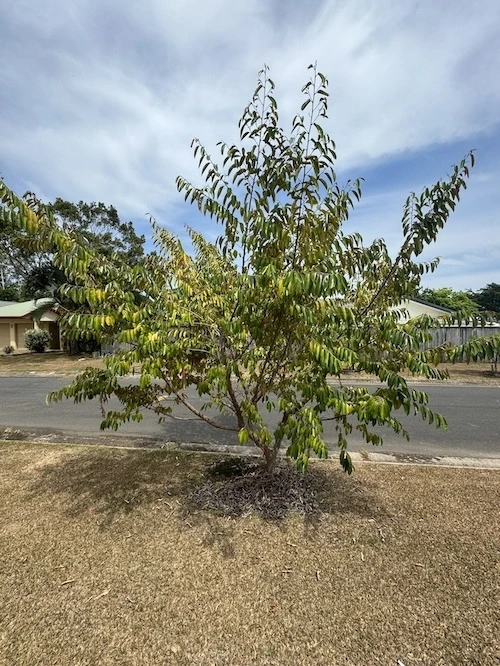Table of contents
Star Apple Tree Australia
Star apple tree care should see your tree produce delicious fruit. The star apple Chrysophyllum cainito is a tropical fruit tree. With its origins in Central America and the West Indies, it is now also very popular in South America and Asia.
This tree can be grown in Australia. Indeed it grows quite well in the hot tropical lowlands of Northern Australia.
Star Apple Varieties
Star fruit come in two main colour types, purple and greenish yellow. Varieties exist in these two main colours. For example the popular ‘Haitian Star’ is a purple peel type, while the ‘Blanco Star’ is a green peel variety.
Location and Soil
This tree is forgiving of poor soil. It grows particularly well in deep, rich earth, clayey loam, sand, or limestone. However, it must have good drainage.
Star Apple Tree Picture

Propagation of Star Apple Tree
Time needed: 4 minutes
How to Grow Star Apple from Seed
- Remove seeds:
Cut a ripe fruit in half and remove the seeds. Be aware most seeds do not grow true to type.
- Clean Seeds:
Rinse seeds then leave them in a bowl for 24 hours. Seeds lose viability fairly quickly. You should sow them within a month of collection.
- Prepare:
Fill a starting pot with potting mix and then water thoroughly.
- Sow:
Place the seeds on the surface of the potting mix. Spread a thin layer of potting mix over the seeds. Then lightly tap it down.
- Germination:
Leave the pot in a sunny location and water at least weekly. Do not overdo it, as your seed will rot if your medium is permanently soggy. You should see a sprout after 25 – 30 days.
- Transplant:
After a month or two transplant your seedling into a new pot or to your preferred location in the garden.
- Wait 5 to 10 years:
Yes, if you want to grow star apple from seed, that is how long you may have to wait to see your first fruit.
While the star apple tree can be grown from seed, most often it is grown from a cutting from an existing tree. Cuttings taken from mature trees are known to root well.
Star Apple Tree Pollination
Some cultivars (e.g., ‘Haitian Star’ and ‘Blanco Star’) don’t need cross pollination to set fruit. However, some may require cross pollination in order to set fruit.
Star Apple Tree Care
Caring for a star apple tree involves providing the right tropical or subtropical conditions, as this tree thrives in warm, humid environments. Here are some tips on star apple tree care:
Fertilising
We fertilise at the start of the ‘wet season’ and two more times before the end of the wet. That is just 3 times per year, two months apart.
Watering
Make sure you water your tree every week for the first two months after planting. After this you will need to water only every few weeks during the dry season (a nice deep watering). During a typical wet season no watering is necessary.
Mulching around your trees will reduce evaporation and help you save a little on water. Plus your tree will love it.
Pests and Diseases
This tree is more disease resistant than most. However, the biggest problems are usually fruit flies, fungal infections, leaf spots and birds.
To address disease, it is good practice to remove dead and diseased leaves. Pruning your star apple tree to increase air-flow through the canopy can also prove most helpful.
Star Apple Tree Size
These are big trees. They grow as tall as 7.9 to 30.5 metres (25 to 100 ft), with a big round canopy. However, pruning can allow you to keep your tree a manageable size.
Prune just before the end of the dry season. Of course you do not ‘need’ to prune your tree. However, you may want to if you intend to keep your star apple tree a manageable size.
Lifespan of Star Apple Tree
The star apple tree can live for approximately 20 to 50 years or more under favourable conditions. Its lifespan depends on factors like climate, soil quality, pest and disease management, and general care. In ideal tropical environments, where it gets the warm temperatures and high humidity it prefers, the tree has the potential to live closer to the upper end of this range and remain productive in fruit-bearing for many years.
Regular care, including watering, proper soil maintenance, pruning, and pest control, can help extend the tree’s lifespan and ensure continuous fruit production. However, extreme weather, inadequate care, or poor soil conditions can reduce its longevity.
Eating the Star Apple
Wash the fruit of the star apple tree and then cut in half. Then remove the outer skin from each half (the skin and seeds of this fruit are not edible). However, the remaining white milky flesh and rubbery membrane that can be eaten. Indeed you will find it sweet and tasty.
Usually, the way the fruit is eaten is to scoop out the edible part with a spoon and eat it fresh. However, the pulp is also used in other ways, such as juices and jellies.

Star Apple Benefits
This fruit of the star apple tree offers many health benefits. Indeed it is widely known to help with diabetes and rheumatism.
Fibre
Star apple has a high fibre content. So this helps keeps the digestive tract to stay healthy and regular.
Immune System
This fruit is a fantastic source of vitamin C which helps strengthen the immune system. In addition, it is good for your skin and boosts your immune system.
Antioxidants
In addition, the fruit contains antioxidants. Consequently these antioxidants fight free radicals in the body. Consequently, antioxidants can help reduce the risk of a number of diseases, including cancer and heart disease.
Prebiotics
Furthermore the star apple contains prebiotic fibre that helps to promote healthy gut bacteria. Gut health is increasingly being recognised for the contribution it makes to your overall wellbeing.
Star Apple Tree for Sale
Consider visiting a local plant nursery. You will be surprised with what they have to offer.
Star Apple Tree for Sale Australia
This plant is occasionally sold at Bunnings. You may find one in a small pot in the nursery section.
If you live in the tropics, why not consider supporting a local nursery? They often have what you need and a lot more besides. Also, often local nurseries sell products suited to the local climate. In tropical areas local nurseries often sell this tree.
In conclusion, thank you for reading about the star apple tree.
Other Tropical Fruits
- Black Sapote
- Custard Apple
- Dragon Fruit
- Grumichama
- Guava Tree
- Jaboticaba
- Kumquat Tree
- Lemonade Tree
- Mamey Sapote
- Mulberries
- Natal Plum
- Passion Fruit
- Paw Paw
- Rambutan
- Watermelon


Comments
5 responses to “Star Apple Tree Guide”
Hi Rob, our Star Apple appears to have a black sooty fungal infestation…is this powdery mildew or ptytoptraa? And what would you recommend to treat it?
if you try goggle or YouTube, you will get a more more informed response than i can give you. There are better experts than me and i don’ want to give you the wrong advise. I hope that is ok.
Regards
Rob
[…] Star Apple […]
[…] Star Apple Tree […]
[…] Star Apple Tree […]